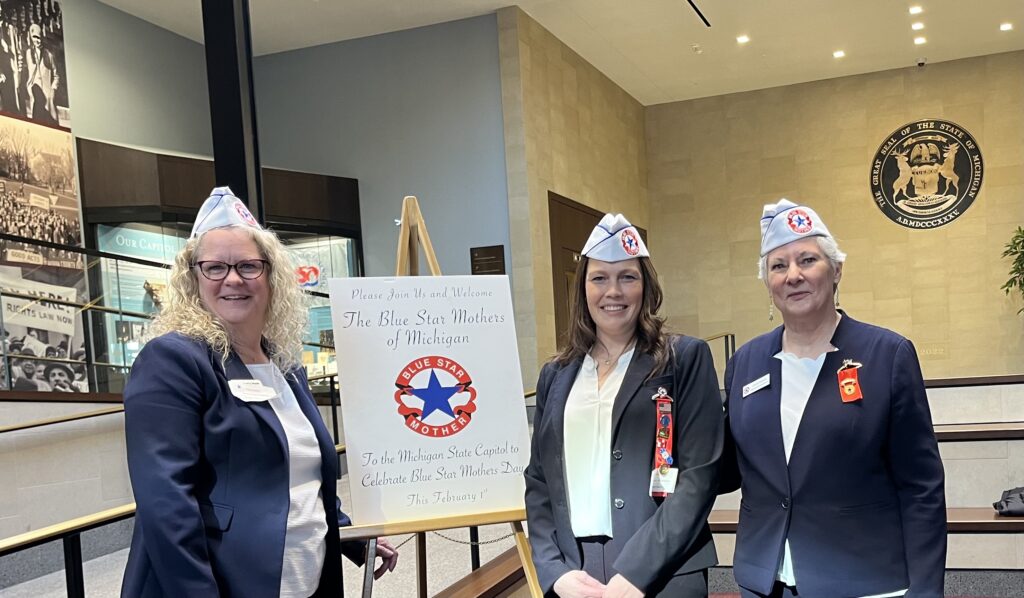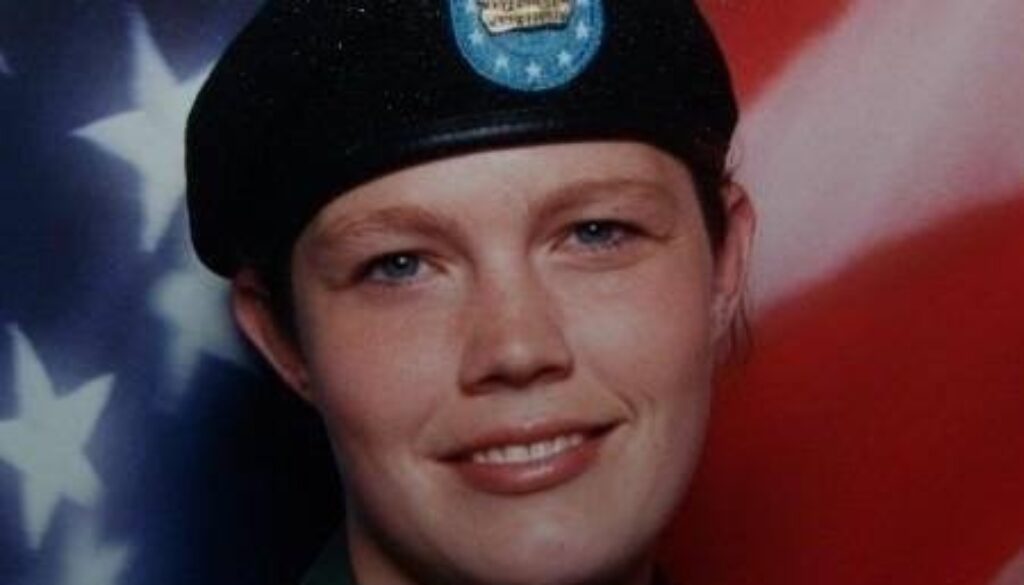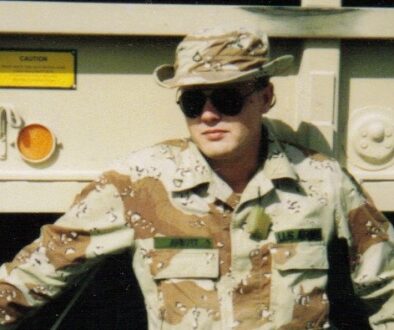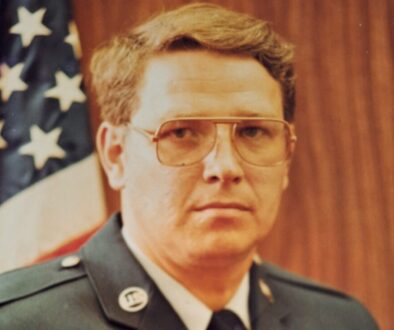Specialist Stacy Breithaupt, U.S. Army – Treating Soldiers and Detainees – A Combat Medic’s Story
Military members sign up to serve in whatever capacity their talents allow. Specialist Stacy Breithaupt knew early on she had an aptitude for healthcare, so it was only natural she became a combat medic. Soon she found herself treating soldiers and their families both in the United States and abroad. Then, in 2005, she deployed to Iraq working with detainees at the mammoth insurgent detention center at Camp Bucca. Less than one year later, it would be Stacy on the receiving end of medical care.
Stacy was born in September 1979 in Burton, Michigan, and grew up in typical Midwestern fashion. She was the second oldest of four siblings, all girls. She played sports for Bendle High School and enjoyed roller speed skating. She also earned money by babysitting, working as a cashier at Marco’s Pizza, and serving as a hostess at an Olive Garden restaurant. At that point, Stacy’s life stopped being typical because she had a plan.
Bored with high school during her senior year, Stacy sat for the GED exam in March 1997 and graduated that same month. With her high school degree in hand and influenced by the positive Army experience of her Aunt Teri, she marched to the nearest Army recruiting station. She enlisted in the Delayed Entry Program with an active duty start date of May 1. She was just seventeen years old.
When May 1 arrived and Stacy’s high school friends were sitting in their classes counting down the days until graduation, Stacy’s Army recruiter picked her up at home and dropped her off at the Military Entrance Processing Station (MEPS) in Troy, Michigan. After passing a final physical, taking the oath of enlistment, and spending the night in Troy, she flew to Fort Jackson, South Carolina, to begin her Army career.

Basic training at Fort Jackson brought no surprises. Stacy expected it to be a long and tiring process, and it lived up to her expectations. Still, she did well because she wanted to be there. She already knew how to shoot and was in great physical shape due to her high school sports and speed skating conditioning, so those aspects of her training posed no problems. Her only stumbling block was using topographical maps, a skill she eventually acquired after sufficient practice.
Stacy graduated from basic training just before the Fourth of July. She then began Advanced Individual Training (AIT) as a combat medic at Fort Sam Houston in San Antonio, Texas. There she learned the basic life-saving skills she needed to provide emergency medical care to wounded soldiers on the battlefield. Her job was keep the soldiers alive until they could be transported to medical facilities for more advanced treatment by doctors and nurses. She learned to give IVs, draw blood, manage medical records, administer medications, and triage injured soldiers. To help put what she learned into practice, she worked at the Troop Medical Clinic (TMC) at Fort Sam Houston.
Although Stacy learned quickly and loved every aspect of her training, it did have its drawbacks. Early on, the instructors identified her as having small veins and used her as a training aid anytime they wanted to demonstrate how to perform a difficult blood draw or IV insertion. The hot Texas summer also proved harsh for Stacy since she’d grown up in much cooler Michigan. So much so that three weeks into the course, she had to be hospitalized for three days due to heat exhaustion. For the rest of the training, her instructors repeatedly reminded her to stay hydrated so it wouldn’t happen again.
Stacy graduated second in her class from the combat medic course in October 1997, just one month after her eighteenth birthday. Not only did she qualify as a combat medic, but she also earned her Emergency Medical Technician (EMT) certification. Her performance demonstrated just how much she wanted to be a combat medic.
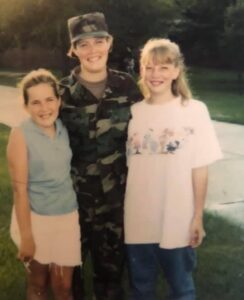
After completing her training, Stacy reported to the 568th Ambulance Company at Camp Humphreys in South Korea. Located forty miles from Seoul and just sixty miles south of the demilitarized zone (DMZ) between South and North Korea, the camp sits on one of the most potentially volatile flashpoints in the world. Adding to the political tension, Stacy initially felt stressed being so far from home and living in a completely different culture. Once she acclimated to her new environment, she settled in and had a great overseas experience.
The 568th Ambulance Company’s leadership played a significant role in Stacy’s successful transition. Not only did they put her to work using her newly acquired medical skills at the Camp Humphreys TMC, but they also gave her flight medical training and assigned her to fly with the “Dustoff” helicopters evacuating injured soldiers by air. The Dustoff work challenged Stacy and made her want to come into work every day, as did her promotion to private second class and eventually private first class. She also worked with Korean soldiers and learned to speak some Korean. She even visited the DMZ and took time to tour other sites in South Korea.
In October 1998, Stacy transferred to the 261st Area Support Medical Battalion (ASMB) at Fort Bragg in Fayetteville, North Carolina. There she provided medical support for the 82nd Airborne Division’s parachute drop zones and the Air Assault School. She also worked at a local civilian hospital to maintain her EMT credentials. She stayed with the 261st ASMB until she transitioned to the Army Reserve in July 1999.
After leaving active duty, Stacy moved back to Michigan near her hometown. She immediately affiliated with the Army Reserve’s 431st Quartermaster Company in Lansing, just over sixty miles away. She drilled with the unit one weekend each month and an additional two weeks each year making sure the company’s soldiers were medically ready to deploy. This meant reviewing medical records to ensure soldiers had all their shots and were up to date on their dental checkups. She also followed-up with appropriate health resources for any soldiers with open medical needs. She did this until July 2003, when her original Army recruiter, now a reservist with the 785th Military Police Battalion, asked her to join his unit to help prepare it for an upcoming deployment to Iraq.
Stacy’s responsibilities at the 785th Military Police Battalion mirrored what she did for the quartermaster company. In addition, she taught the combat lifesaver course for the unit’s soldiers so they would be prepared to get a wounded comrade off the battlefield and to the medical treatment they needed. During these classes, Stacy taught the soldiers basic emergency tactical trauma techniques like administering IVs, applying pressure to wounds and bandaging them, and using tourniquets to stop bleeding.
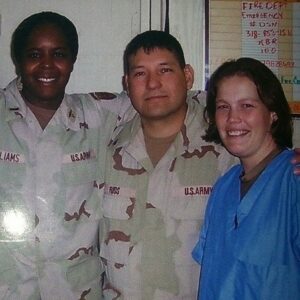
As the time for deployment drew closer, the 785th Military Police Battalion moved from its headquarters in Fraser, Michigan, to Fort McCoy in Wisconsin to complete required readiness processing. At the individual soldier level, this involved things like signing powers of attorney, executing wills, and reviewing service records to ensure they were accurate and complete. After Fort McCoy, Stacy and her battalion moved to Fort Dix, New Jersey, to learn the specific skills necessary for their upcoming assignment as military police providing security for the Theater Internment Facility (TIF) at Camp Bucca in southern Iraq. The TIF held Iraqi insurgents detained during the Iraq War and was a dangerous place to work. In fact, while Stacy and the rest of the company were training at Fort Dix, the detainees at the camp took a soldier hostage and rioted. Eventually, U.S. forces brought the situation under control, but not before four detainees were killed and others injured.
The training at Fort Dix was intense. In addition to practicing riot control techniques, the company rehearsed providing security for convoys, safely handling and moving detainees, and managing and providing security for the camp’s Special Housing Unit (SHU). As the company’s medic, Stacy needed additional training to prepare her to provide medical care for detainees. Accordingly, the battalion sent her and the other medical staff for a three-week course at Camp Shelby in Mississippi, where she was the only woman participating in a class of men. That got the course off to an awkward start, as there were no separate accommodations for women and a guard had to be posted outside the restrooms anytime Stacy used them. After four days, the course administrators moved her to a hotel off base and life became easier for everyone. Stacy went on to recertify as an EMT by obtaining her EMT-Intermediate certification, and she earned her Tactical Combat Casualty Care (TC3) designation. After completing the course, she rejoined the battalion still training at Fort Dix.
In May 2005, the 785th Military Police Battalion departed Fort Dix and headed for Camp Bucca. Enroute, the company stopped at Camp Buehring in northwest Kuwait to acclimate to the harsh desert environment. Stacy, now a specialist, and the rest of the battalion finally arrived at Camp Bucca near Umm Qasr in southern Iraq in June 2005.
For the first three months of the deployment, Stacy worked at Camp Bucca’s TMC providing medical care for U.S. soldiers and civilian contractors working at the camp. After that initial period, she assisted the company’s medical officer providing medical care for the detainees in the TIF. This included providing basic emergency care to any detainees who might be injured as well as giving them their medications, conducting blood draws, and administering IVs. She worked across three open-air detainee compounds housing over one hundred detainees each, making tracking and sorting their medications a challenge. Because the detainees were unpredictable and could be dangerous, Stacy had to be alert and ready for anything whenever she worked within the facility.
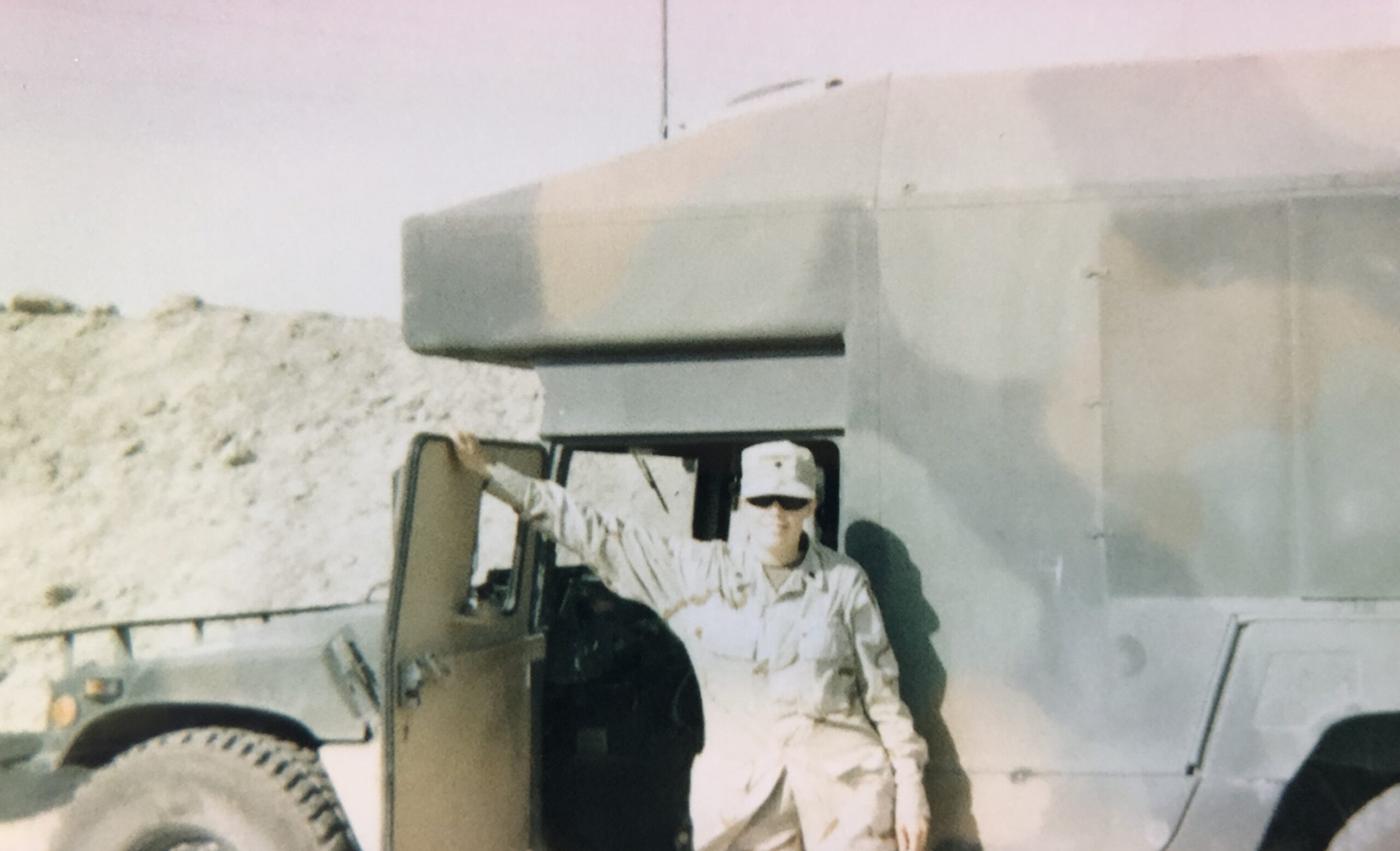
In addition to her responsibilities within the TIF, Stacy participated in convoys transporting detainees between Camp Bucca and the detention facility at Abu Ghraib, located approximately 350 miles away in the vicinity of Baghdad. During these convoys, she rode in an ambulance and had to be prepared to render any medical assistance required, including administering medications the detainees needed to take during the transport. The convoys were always at risk of attack, either by insurgent forces or by improvised explosive devices (IEDs) hidden along the route. To underline the danger, Apache attack helicopters flew above the convoys to ward off would-be attackers. Still, the convoys were vulnerable. In September, two servicemembers from Camp Bucca were killed when their vehicle struck an IED. One month later, on October 25, Stacy lost a good friend, Specialist Christopher T. Monroe, when he was killed during a convoy.
The danger continued even after the convoys reached their destinations. Once, after arriving at Abu Ghraib, Stacy was walking in the camp when a large explosion detonated near the front gate. The force was powerful enough to knock bricks off the wall near where Stacy stood. She also had to deal with a riot at Camp Bucca, where her parked vehicle was destroyed and a detainee escaped. Another time, three detainees managed to dig their way out of the compound. Although they were recaptured, the specter of detainees running loose around the camp kept Stacy on edge.
Stacy also participated in recovery operations when IEDs disabled or destroyed convoy vehicles. When this occurred, wreckers were dispatched to recover the damaged vehicles. If anyone was injured or killed in the attack, Stacy accompanied the recovery team in an ambulance to help treat the injured parties and bring them or any deceased persons back to the camp.
In November 2005, Stacy started feeling run down. She initially attributed her condition to working in the TIF eighteen hours a day, seven days a week, while wearing all the required protective gear in the oppressive Iraqi heat. Eventually, the company sent her to Camp Arifjan in Kuwait, where she was diagnosed with a bacterial infection in her stomach. While still foggy from the anesthetics used during the exam, she was returned to Camp Bucca with antibiotics and directed to go back to work because the battalion needed her.
The antibiotics did not work, and Stacy’s stomach condition worsened to the point where, by the beginning of January 2006, she could no longer eat. Major Grundy, the battalion medical officer she worked for, tried to help, but he didn’t have the necessary testing equipment and therefore had no idea what was causing her symptoms. Still, her command expected her to work although she struggled to make it through each day. When Stacy could take it no more, she told her commanding officer she could no longer work and that if he didn’t send her for treatment, she would be leaving Iraq in a body bag. The battalion finally medevacked her to the Army hospital in Langstuhl, Germany.
When Stacy arrived at the Army hospital, she weighed only eighty-nine pounds. The doctors spent the next week ensuring she was stable enough to transport back to the United States. At the end of January, she was medevacked on a C-130 to Walter Reed National Military Medical Center in Bethesda, Maryland. When she woke up, the command leadership team of the 18th Military Police Brigade was there by her bedside. They wanted to know her perspective on how her condition had been allowed to get to the point it had.
Although Stacy appreciated their willingness to hear her story, she was angry. She felt as though she had taken excellent care of the 785th Military Police Battalion’s soldiers, but when it came to her own health, the command had let her down. Now she just wanted to recuperate and get on with her life as a civilian. The healthcare team at Walter Reed helped make that possible by correctly diagnosing the cause of her condition as an intestinal parasite she had somehow acquired in Iraq. The good news was now that the problem had been identified, it could be treated. That bad news was the condition had been allowed to fester for so long, Stacy sustained permanent organ damage. She spent the next three months at Walter Reed and Fort Dix getting back on her feet. Eventually, she would undergo thirteen surgeries to repair the damage caused by the parasite.
Stacy did not wait for the surgeries before transitioning out of the Army. In fact, she was discharged from Walter Reed on April 1, 2006, and honorably discharged from the Army Reserve on the same day. She then returned to Michigan to continue her treatment through the Veterans Administration (VA).
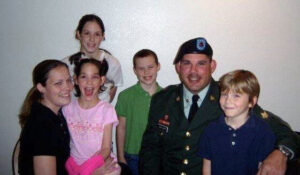
Although Stacy no longer wore an Army uniform, her association with the Army continued through her husband, Sergeant David Breithaupt. He took active duty orders in June 2007, and Stacy moved with him to Fort Stewart, Georgia. In July 2008—the first time Stacy was healthy enough to work again—she accepted a civilian position as the 92nd Engineer Battalion Family Readiness Support Assistant helping Army family members understand the support programs available to them. She would take similar civilian positions with the 3rd Battalion of the 7th Infantry Regiment at Fort Stewart, the 321st Infantry Regiment at the Army Reserve Center in Winterville, North Carolina, and the 94th Training Division at Fort Lee, Virginia. Stacy finally retired from the Civil Service in 2021. At the time, she was working with the Greenville North Carolina VA. During her Civil Service employment she also earned her bachelor’s degree in business administration.
Stacy and David now live in Michigan. They raised four children together: Caleb, Melissa (who sadly passed away in November 2019), Maegen, and Anthony. Staff Sergeant Anthony Breithaupt followed in his parents’ footsteps and is a Ranger scout in the 101st Airborne Division. Stacy and David enjoy traveling and spending time with family. Wanting to continue her lifelong mission of supporting the military, veterans, and their families, Stacy is an active member of Blue Star Mothers of America.
Voices to Veterans is proud to salute Specialist Stacy Breithaupt for her dedicated years of service to the Army. At great personal cost to herself, she rendered medical care to soldiers and civilians in need both in peacetime and in war. She deployed to Iraq at a crucial time in the Iraq War, rendering medical assistance to friend and foe alike. She then defeated a debilitating illness, only to continue serving Army families in her civilian capacity. We thank her for all her sacrifices and wish her fair winds and following seas.
If you enjoyed Stacy’s story, please sign up for the Voices to Veterans Spotlight monthly newsletter by clicking here. Once each month, you’ll receive a new written veteran’s story directly in your mailbox. Best of all, it’s free and you can unsubscribe at any time.
